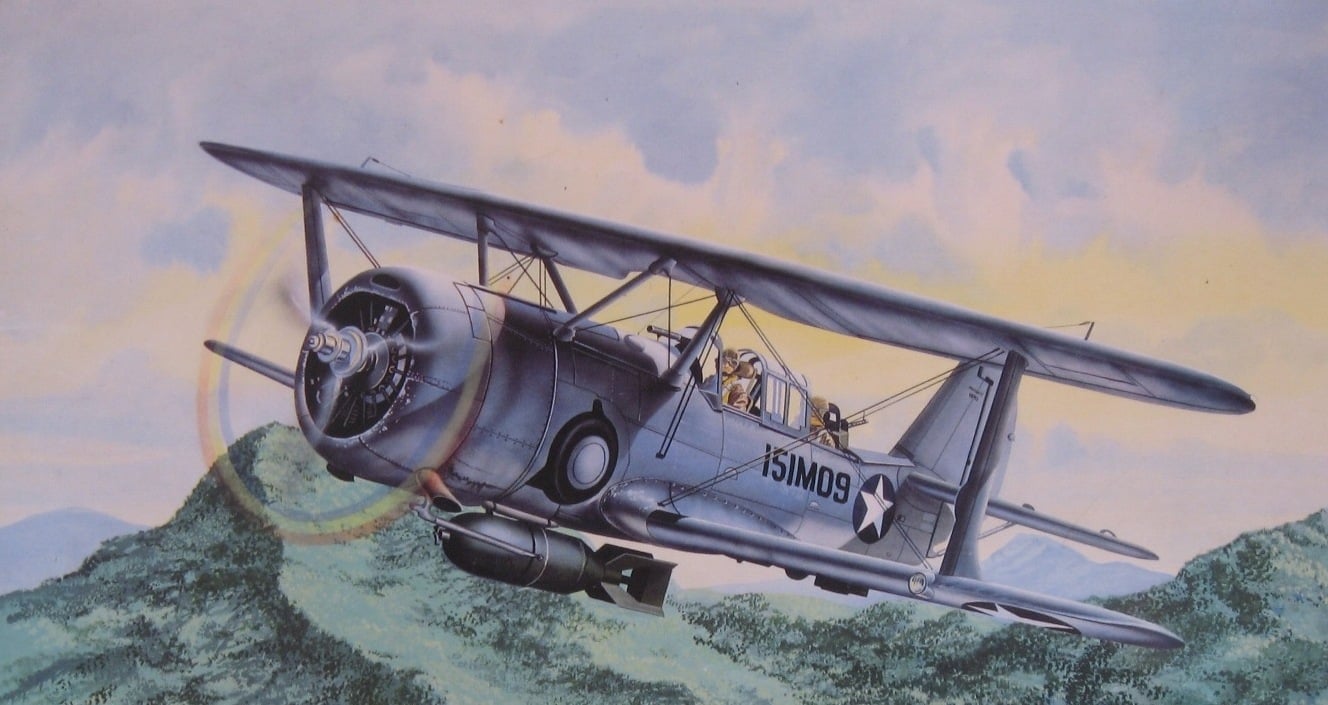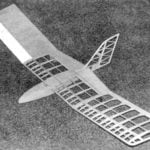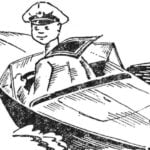 In the history of American carrier-based aircraft has a prominent place scout bomber company Curtiss SBC HELLDIVER, which was the last carrier-based aircraft-a biplane at the naval aviation of the USA. United States Navy signed June 30, 1932, with the Curtiss firm a contract to develop a new two-seat carrier-based fighter-monoplane XF12C-1 with a two-engine R1510-92 625 power HP company Wright — all-metal, closed cockpit, retractable landing gear and high wing type “parasol”.
In the history of American carrier-based aircraft has a prominent place scout bomber company Curtiss SBC HELLDIVER, which was the last carrier-based aircraft-a biplane at the naval aviation of the USA. United States Navy signed June 30, 1932, with the Curtiss firm a contract to develop a new two-seat carrier-based fighter-monoplane XF12C-1 with a two-engine R1510-92 625 power HP company Wright — all-metal, closed cockpit, retractable landing gear and high wing type “parasol”.
His first flight of the new fighter was made in October 1933.
Simultaneously with the development of the monoplane Curtiss firm has built single-seat fighter biplane XF11C-3 which was a deep modernization of the last of the famous series of “hawks” fighter F11C-2 Goshawk. By the way, the new car has been stored the landing gear retraction system by pressing the main wheels to the niches on the side of the fuselage, first proposed by the firm Grumman.
In 1933, the Navy refused double deck fighters. And a new aircraft company Curtiss redeveloped. On the XF11C-3 had entrusted the execution of fighter-bomber tasks, and the XF12C-1 — reconnaissance. Changed and designation: the planes are called, respectively XBF2C and XS4C-1.
In February 1934 fighter-bomber BF2C-1 with engines R1820-04 700 HP has launched a small series of 27 aircraft. The machine was armed with two 7.62 mm Browning machine guns, four of 52.7-kg bombs or one bomb caliber 215 kg In January 1934, the scope of scout XS4C-1 has expanded, making him run bomber tasks. The final designation of the aircraft was CACIBs-1. Changing the destination of the aircraft resulted in the installation of the new engine— Wright R1820-80 with a capacity of 625 HP During the next test flight the machine has demonstrated fairly high for its time, the speed of 350 km/h at an altitude of 2440 m. the Maximum flight altitude amounted to 7315 m.
In flight tests of the aircraft was dive bombing. During four flights on 14 June 1934 the aircraft was to demonstrate the ability to strike at ground targets with a dive 227-kg bombs.
The car was off from the factory airfield. In the first two departures XSBC-1 showed excellent results. In the first fight bomber overclocked to 420 km/h in a dive, and the second — to 470 km/h Maximum overload at the output has reached 4g. The inspections of construction after planting showed residual deformations or other damage. However, the pilot P Hogarth complained of a slight tail buffeting, but nobody paid serious attention. Before the fourth flight, the weather began to deteriorate immediately after takeoff, the plane went into cloud and was lost visually by ground observers.
Suddenly even the noise of the motor was interrupted by a sharp Bang, like an explosion. The sound was heard, but no car, no pilot no one saw. A search began. XSBC-1 were found in 10 km from the runway near the small city of Lancaster. The fuselage and wing were lying separately and was in good condition, except for a few dents received in the fall. Suspended bomb is not detonated. The pilot was found in the nearest city hospital, where his broken arms and legs drove the ambulance, called by the locals.
As told by the pilot the accident occurred on the entry of the machine into a dive at a relatively low speed. It all started with the fact that the rotating propeller lost a blade, which resulted in strong vibration. The first could not stand stabilizer — its surface literally happened to the keel. Began a disorderly fall. The pilot managed to escape from the cockpit, and he left the plane at an altitude of about 3600 m. the Parachute opened automatically.
After analyzing the causes of the accident and ACE revealed the shortcomings of the design firm July 6, 1934, presented to the Bureau of aviation of the Navy (BuAer) a new, significantly redesigned version of the aircraft. The designers carefully studied and strengthened all the weak components and assemblies of the machine, mounted one wing, turning it so the biplane, developed a new fuselage-monocoque, getting rid of the roll cage, and used a more robust three-bladed propeller Curtiss Electric company. In addition, the lamp tried to seamlessly fit into the contours of the fuselage, and the rear fairing made for the emerging of Heliconia the sector of fire of the rear gunner. The increased mass and drag was offset by the installation of modern engine Weight XR1510-12 700 HP
The military has approved the project and gave him the designation XSBC-2. On the ninth of December, 1935, the plane rose into the air.


Scout bomber Curtiss SBC-4 HELLDIVER:
1 —the engine hood Wright Rl 510-92; 2— brace wing; 3 — clearance lights; 4 — reinforced (top) of the wing struts; 5 — cable antenna; 6 — cabin crew; 7 — keel; 8 — keel strut antenna; 9 — rudder; 10 — pull rudder; 11 — trimmer of the rudder; 12 — fold niches tail strut; 13 — a boarding hook; 14 — operating footboard; 15 — a three-bladed propeller; 16 — sleeve screw; 17 — cooling jacket of the engine R1510 Wright-92; 18 — exhaust pipe; 19 — removable hood engine Wright R1535-82; 20 — removable hood engine R1510-I2; 21 — cooling jacket of the engine Wright XR1510-12; 22 — front wing radio station, 23 — optical sight; 24 — wing stand; 25 — fold niche of cleaning the main chassis; a 26 — detachable operating panel; 27 — hood Curtiss SR1820F-3; 28 — a machine gun course; 29 maintenance hatch; 30 — wheel main landing gear in the retracted position; 31 — the air intake of the carburetor; 32— the crack of the exhaust air; a 33 — visor of the cockpit; 34 — sliding part of the canopy pilot; 35,36 — the sliding part of the canopy radio operator-gunner; 37 — retractable fairing; 38 — a tail marker light; 39—control rod trimmer; 40 — the tail wheel in the retracted position; 41 — flaps; 42 — PVD; 43 — detachable panel; 44 — removable hood engine Wright R1820-22 CYCLONE; 45 — brace struts of the upper wing; 46— hook brake hook; 47 — root rib of the lower wing; 48 — external fuel tank; 49 — brace the upper wing; 50— capture the displacement mechanism of the bomb; 51 — 454-kg bomb; 52 footpegs; 53 maintenance access doors control system rudder; 54 — brace stabilizer; 55 rocking of the trimmer Aileron; 56— drill fire; 57 — gripping mechanism of the displacement of the bomb in the released position; 58 — strut tail wheel in the released position; 59— tailwheel landing (not compressed) position; 60,62 — wheel main landing gear in the landing compressed and not compressed positions; 61 — main landing gear; 63 — control rod Aileron trimmer; 64 — fairing in the retracted position; 65 plate wheel wells; 66 — strut main landing gear, the 67 — pull mechanism to retract the main landing gear; 68 — Aileron; 69 — trimmer Aileron; 70 — balancing knife Aileron (is on earth); 71 — flaps; 72 — stabilizer; 73 — elevators; 74 — trimmer of the Elevator; 75 — fairing thrust deflection of the flap; 76 end section of the wing; 77 — the center section of the upper wing; 78 — Aileron (bottom view); of 79.80 — Central and bottom panels of the dashboard; 81 — the handle of the Board; 82 — wing bomb racks; 83 — removable lower wing panel; 84 spotlight; 85 landing spotlight; 86 — a machine gun course; 87—turret gun in the retracted (stowed) position; the 88 — node mounting a machine gun; 89— guide; 90 — tape braces
Production aircraft, the first of which passed into operation in June 1937, at the request of the fleet was equipped with engines R1535-94. The top wing of these machines had a small straight sweep and was associated with lower small racks. On the lower wing mounted flaps, which in the dive was used as aerodynamic brakes. The covering of the wings plain. Long flashlight with two sliding sections closed cabin, pilot and shooter. The shooter was armed with a 7.62 mm machine gun, which in cruising flight were placed under the foldable fairing in front of the keel. In the front part of the fuselage was another of the same gun mounted on the starboard side and firing through the propeller. The only one 227-kg bomb hung under the fuselage. Reconnaissance flights instead of bombs hung fuel tank capacity 170,3 L.
The first received a new aircraft squadron VS-5 USS “Yorktown”. Next, squadron VS-6 from the carrier enterprise. The main disadvantage of aircraft SBC-3 was considered to be a small bomb load. To increase to 454 kg firm has offered to install a car engine R1820-22 Cyclone with a capacity of 950 HP, the New engine had a greater diameter, so under it I had to change the shape and size of the hood, and redo the entire nose section SBC-3. Amplified and integrated aircraft weapons— bow is a 7.62 mm machine gun is mounted a 12.7 mm.
The first converted car was the 76th serial instance with the hull number 0582, released in February 1938. He was given the designation XSBC-4. Unlike the prototype XSBC-3, destroyed in static tests, the aircraft for a long time served in a combat squadron and was the only experienced of the aircraft HELLDIVER, passed almost the entire war. He finished his military service in Alaska, where he made 70 sorties in search of enemy submarines. However, none of the submarine his crew to find it and failed.
The order for mass production of 58 aircraft SBC-4 was issued on 5 January 1938, even before the construction of the prototype.
At the beginning of combat training took a prominent place night flights. Part of the aircraft was carrying flares and led the exploration goal, the other applied training bomb attacks. As the target was the ship target “Utah”. The squadron commander was very demanding officer and the schedule of training flights was pretty tight. In one of the flights, all 18 aircraft units Warburton flew through the Grand Canyon below ground level. Ordinary pilots were surprised that there were no accidents and catastrophes. Curtiss SBC-4 HELLDIVER proved to be very reliable and well-managed aircraft.
In early 1939, on the eve of the German attack, the French government ordered 90 aircraft SBC-4 for its naval aviation. The export version of this machine, which the French called the Curtiss 77, has been slightly modified. Instead of guns under the American cartridge put the French 7.7 mm machine guns Darnah. In addition, the aircraft had to set Proektirovanie fuel tanks.
With order fulfillment firm Curtiss was in no hurry, preferring the production of machines for the us Navy. In 1940, France asked with an urgent request for an immediate delivery of the ordered aircraft. In turn, the American government ordered to transfer the French 50 cars from existing parts. SBC-4 was delivered with air bases located I in the States of Washington, Illinois, Missouri,
Minnesota and Michigan, plant of the Curtiss company, where they put new guns and stained in accordance with the French scheme of camouflage.
America has not yet entered the war, and kept neutrality, and therefore directly transfer planes in France, she could not. Decided to overtake the car in Canada, where in Halifax they waited for the French aircraft carrier “béarn”. Pilots participating in the flights, were fictitiously employed in the Curtiss firm. When the aircraft reached the canadian border, cross it by air they were banned. Had to sit on the box and drag the machine across the border for cars and tractors, and then again to take off from appropriate pastures. Finally, the SBC-4 was loaded on a carrier, and June 16, 1940, he accompanied the cruiser “Jeanne D’arc” was released and the sea. Until the surrender of France remained for six days. During this time, the small squadron reached the island of Martinique in the Caribbean sea. Upon learning of the surrender, the SBC-4 hastily unloaded. French Ambassador to the United States, citing the terms of surrender, refused the aircraft. By the time of the Japanese attack on the US machine SBC-3/4 were armed with seven squadrons of carrier-based aircraft.
For the longest time SBC was used on the aircraft carrier “hornet” was cancelled only in March 1942. In aviation, the marine corps SBC HELLDIVER flew until July 1943: the exploration, the adjustment of artillery fire and anti-submarine operations. The last unit of the armed SBC-4, was squadron VMSB-151.
Design description
SBC-4 was a twin-engine single-engine carrier-based scout-bomber with retractable landing gear, made by the scheme biplane.
The fuselage is all-metal, duralumin, like monocoque. At the front there was mounted steel power frame (he has also served on the firewall), which is attached to a motor mount of the engine and fuel control units. Behind the bulkhead was located compartment of the chassis with a strut mounting and the power cylinders retract.
In the lower part of the fuselage (under the chassis) are installed, the holders of a bomb or external fuel tank, and a ramp for launching 454-kg bombs outside the rotation of the propeller used in the bombing in a steep dive. The main fuel tank located in front of the cockpit.

The cockpit and the radio operator was closed with a single fully transparent canopy and consisted of several sections. The first section was a fixed visor of the cockpit, second, savyasachi on the flight back was part of the cockpit, third, the fixed part of the lamp, closed the station and the loop antenna of the radio compass, fourth, savyasachi forward, belonged to the cab radio operator-gunner.
The cockpit was equipped with a full set of navigation equipment, located on the Central panel of the dashboard. On the side panels were placed appliances radio, dashboard bomb arming, and the engine control. On the right side of the cab located control arm brake flaps-flaps are used on takeoff, landing and when the bombing in a dive. Control plane standard: knob control the ailerons and Elevator and pedals associated with the rudder.
In the cockpit of the arrow on the turret was fixed 7.62-mm machine gun, and under the power station and radio compass housed rescue equipment that is used during a forced landing on the water or out of the airfield. In the stowed position the gun is completely removed. To increase the field of fire outside the fairing was folding (section fairing was involved inside of the fuselage).
The wing of the plane made by the scheme biplane, cantilever, all-metal. Upper — single-spar, lower two-spar.
The top wing center section consisted of a rectangular shape and a pair of consoles with a sweep of 10 degrees to the front edge. The wing originally plain, later — dural. Across the rear edge of the end sections of the upper wing housed the ailerons managed trimmers and rejected on the ground balancing knives. Control ailerons hard, from the control stick.
To the fuselage the wing was attached to four pillars. The lower wing consisted of the left and right planes. At the trailing edge of the wing mounted flaps, which were used as flaps in the takeoff and landing and as the brake flaps in the dive. The installation angle of the upper and lower wings 1.5 degrees. Together, they were joined by two shaped t-shirts. Additional rigidity of the box wing attached steel band-brace.
Empennage cantilever, all-metal. The covering of the keel and stabilizer — dural, and rudders and height and fabric. On rudder and elevators installed operated trimmers.
Chassis — tricycle, tailwheel. The main racks were cleaned in a special niche in the fuselage, located in front of the fuel tank. At the tail support in the fuselage was removed just front. System cleaning and landing gear— hydraulic, depreciation of the racks — oil. The main landing wheels were equipped with pneumatic drum brakes.
Powerplant of the aircraft — Phillips 19-cylinder engine of air cooling Wright R1820-22 Cyclone with a capacity of 950 HP with a three-bladed variable-pitch propeller.
The aircraft was armed with two machine guns: the exchange rate of 12,7 mm turret, a movable 7.62 mm in the cockpit, radio operator-gunner. The latter could fully retract and gain a foothold in the cab in the stowed position.
In the Central ventral node hung a 454-kg bomb, and wing holders — two 227-kg bombs.
Performance characteristics of a scout bomber Curtiss SBC-4 HELLDIVER
Wingspan, mm………………….. 10 360
Length, mm………………………………… 8570
Height, mm…………………………………3170
The wing area, m2…………………29,45
Maximum speed
at a height of 4365 m, km/h………………….377
Cruising speed, km/h……………282
Practical ceiling, m……………..7315
Range
bomb load, km………………652
Empty weight, kg……………………….. 2065
Maximum takeoff weight, kg ………….3211
N. Food reserve was, A. CHECHIN, G. Kharkov



